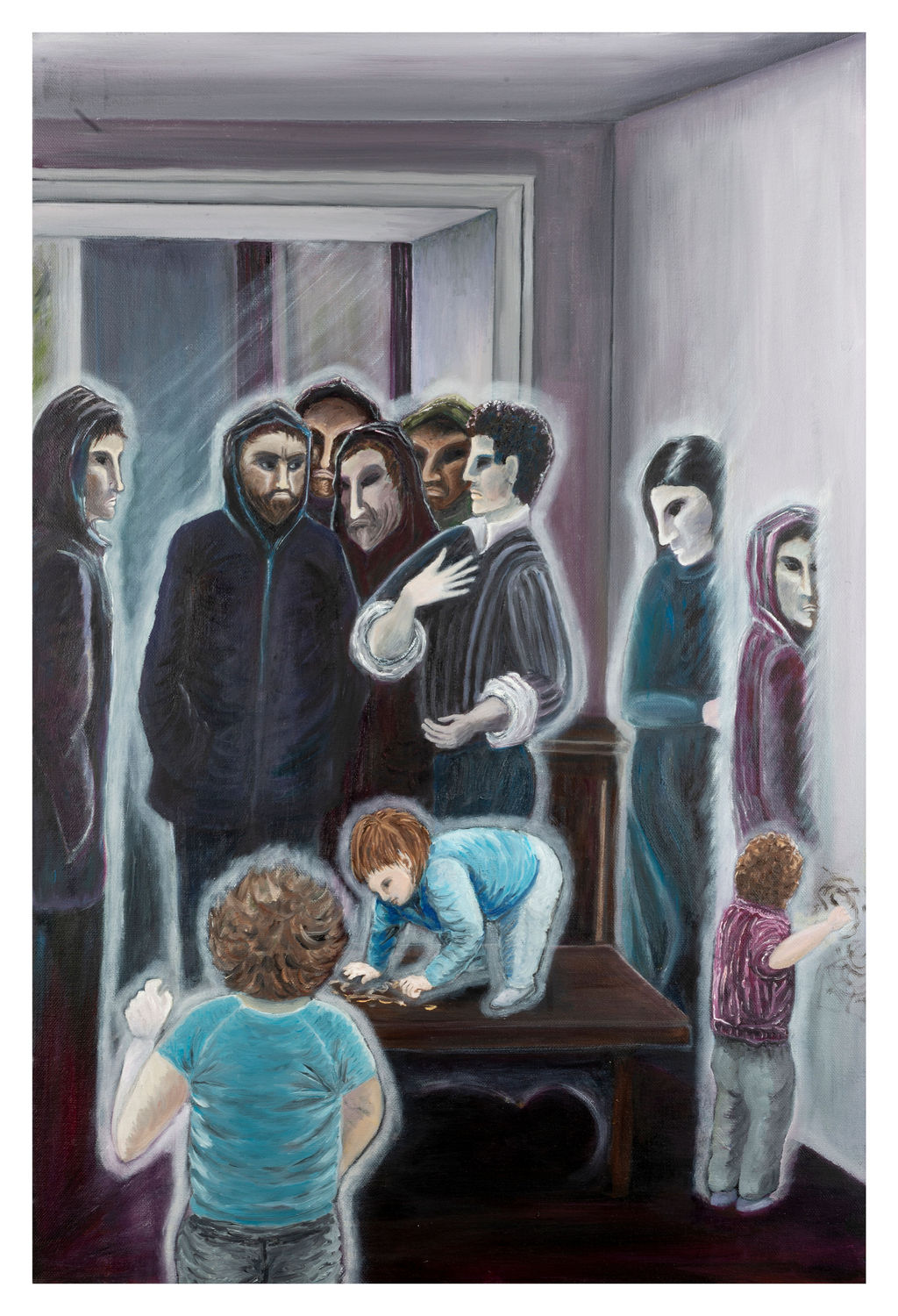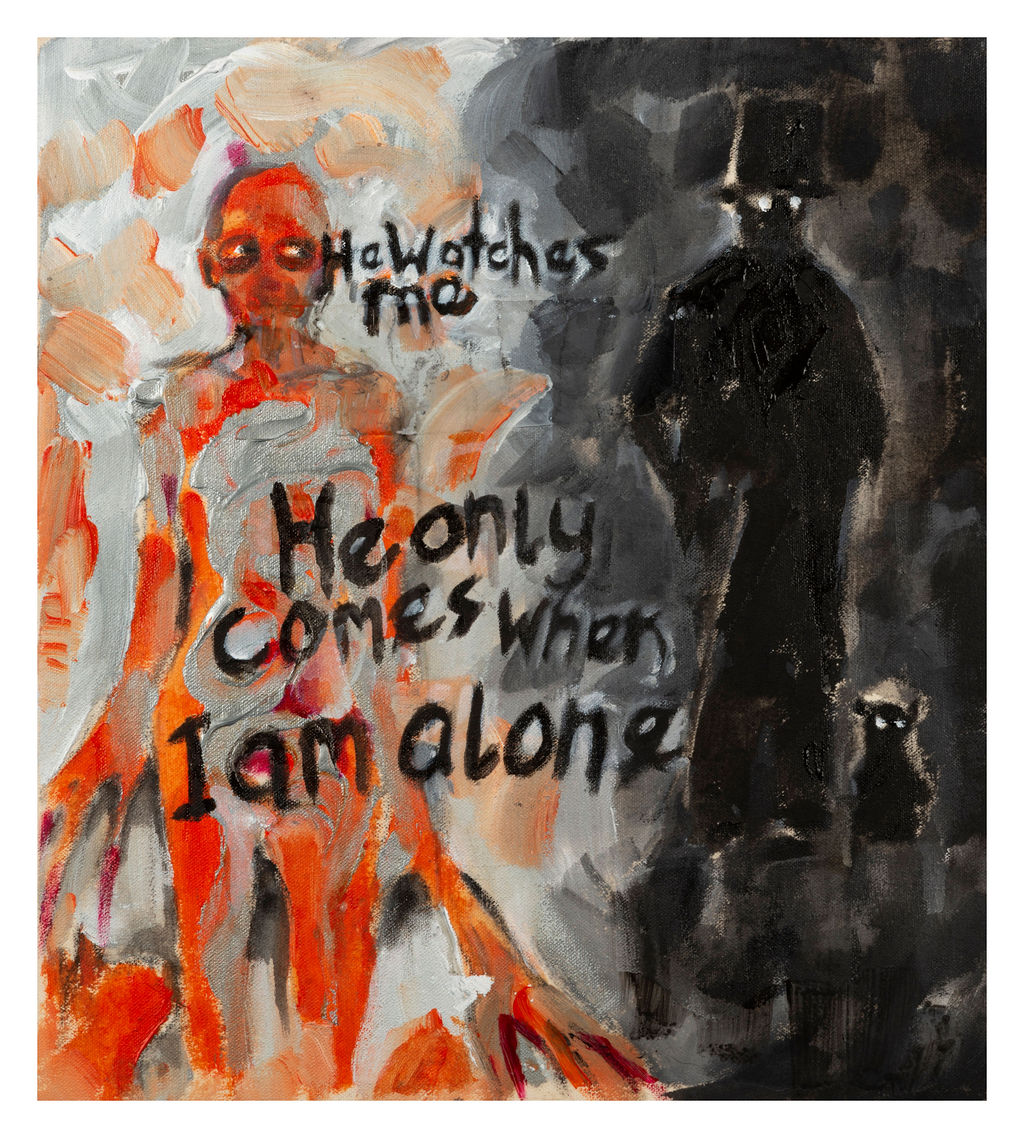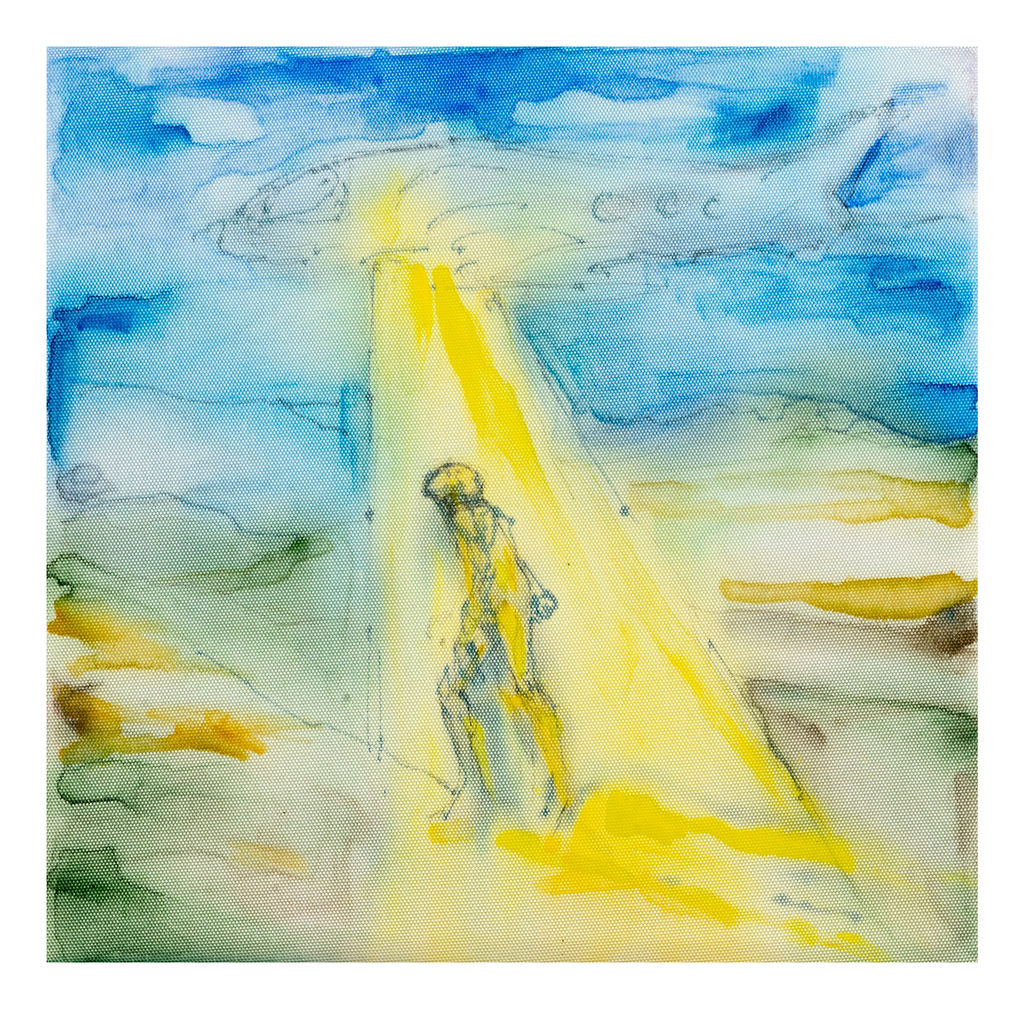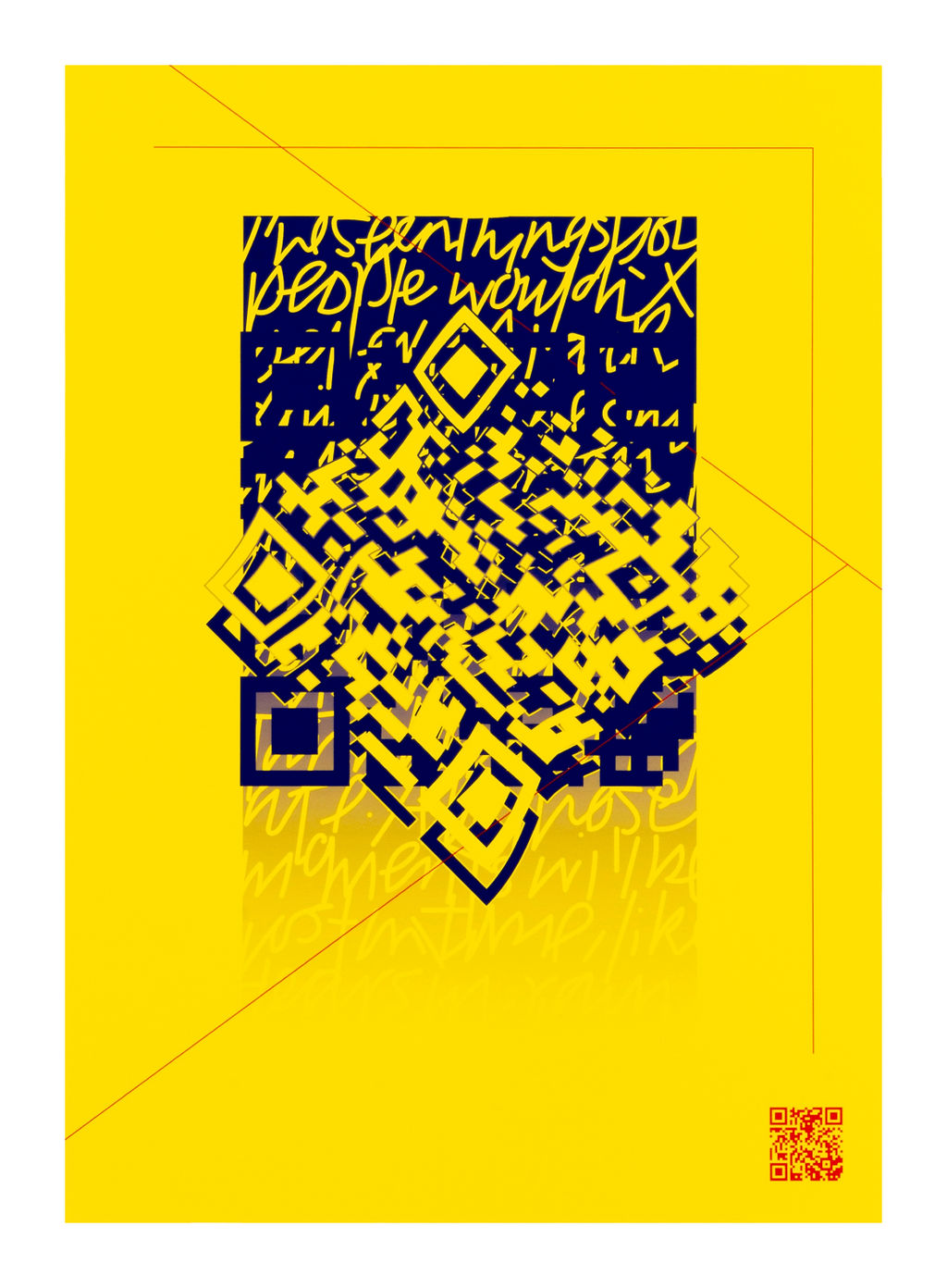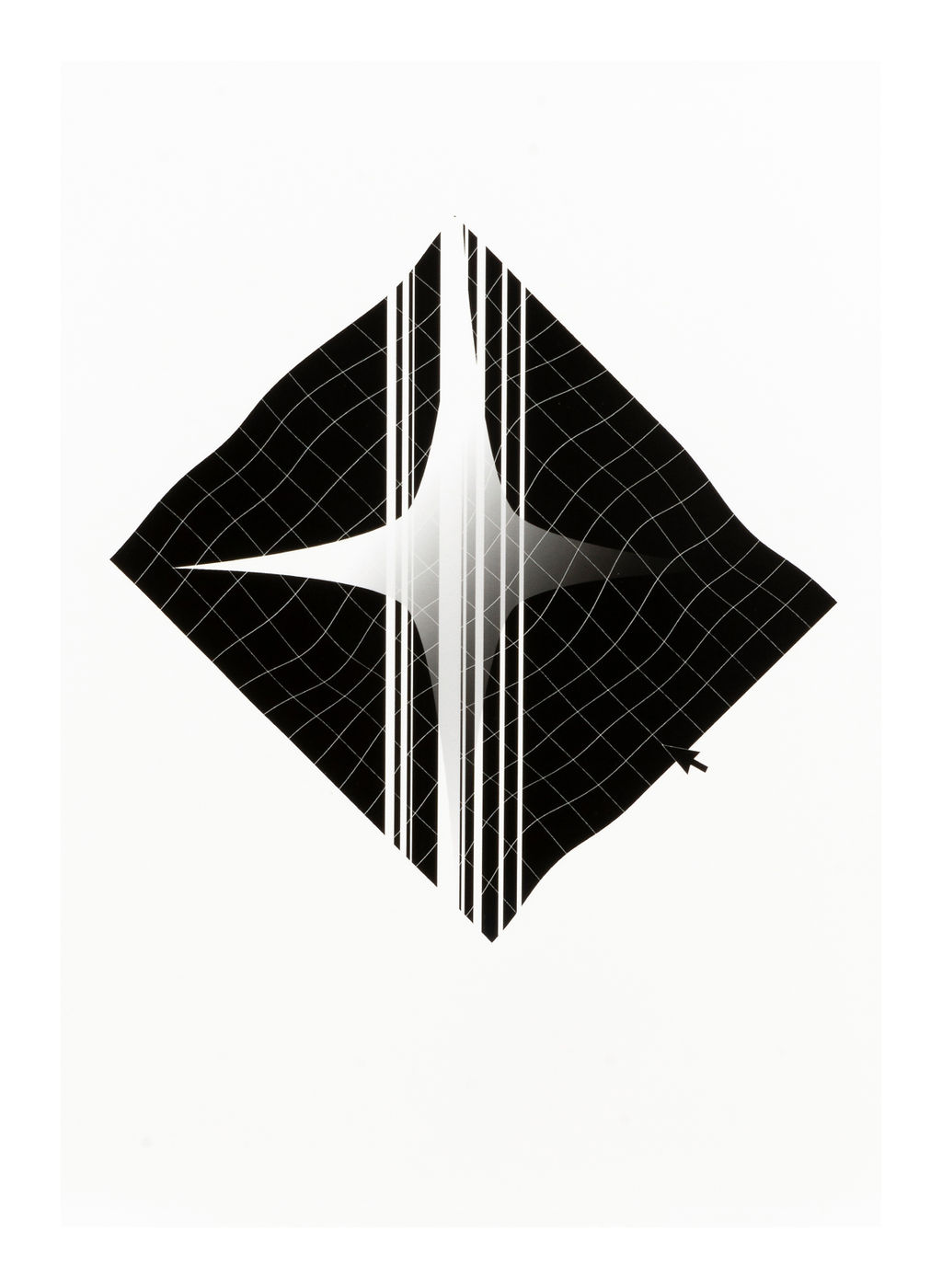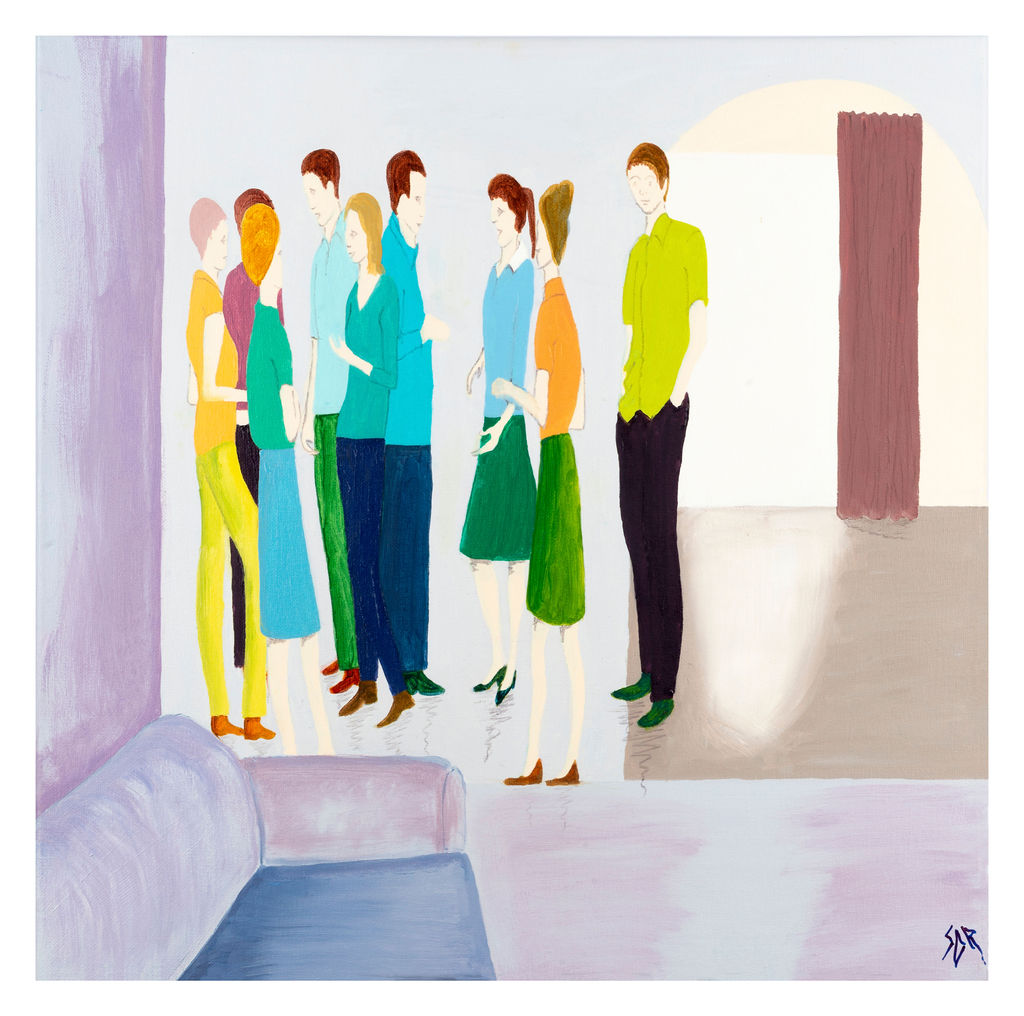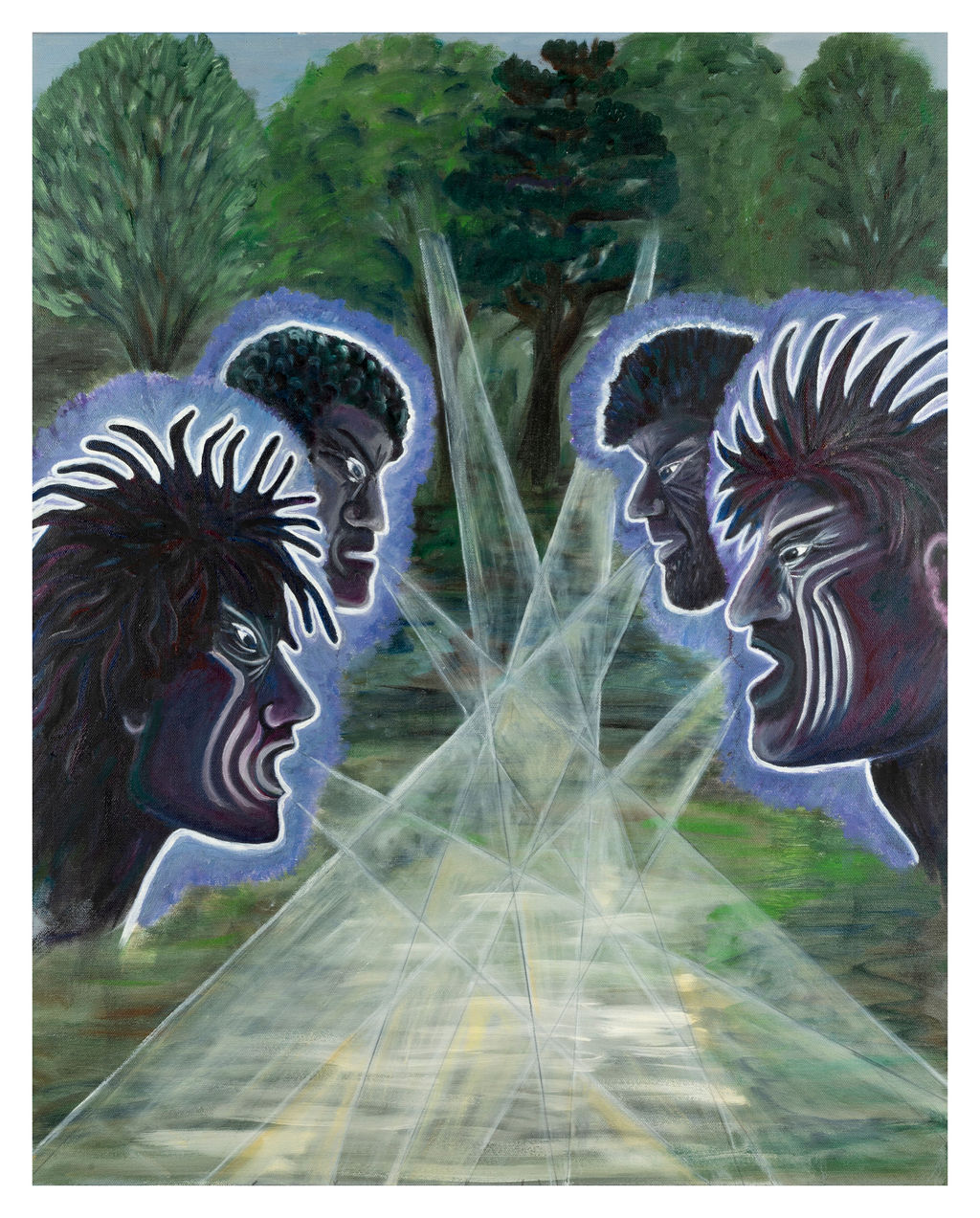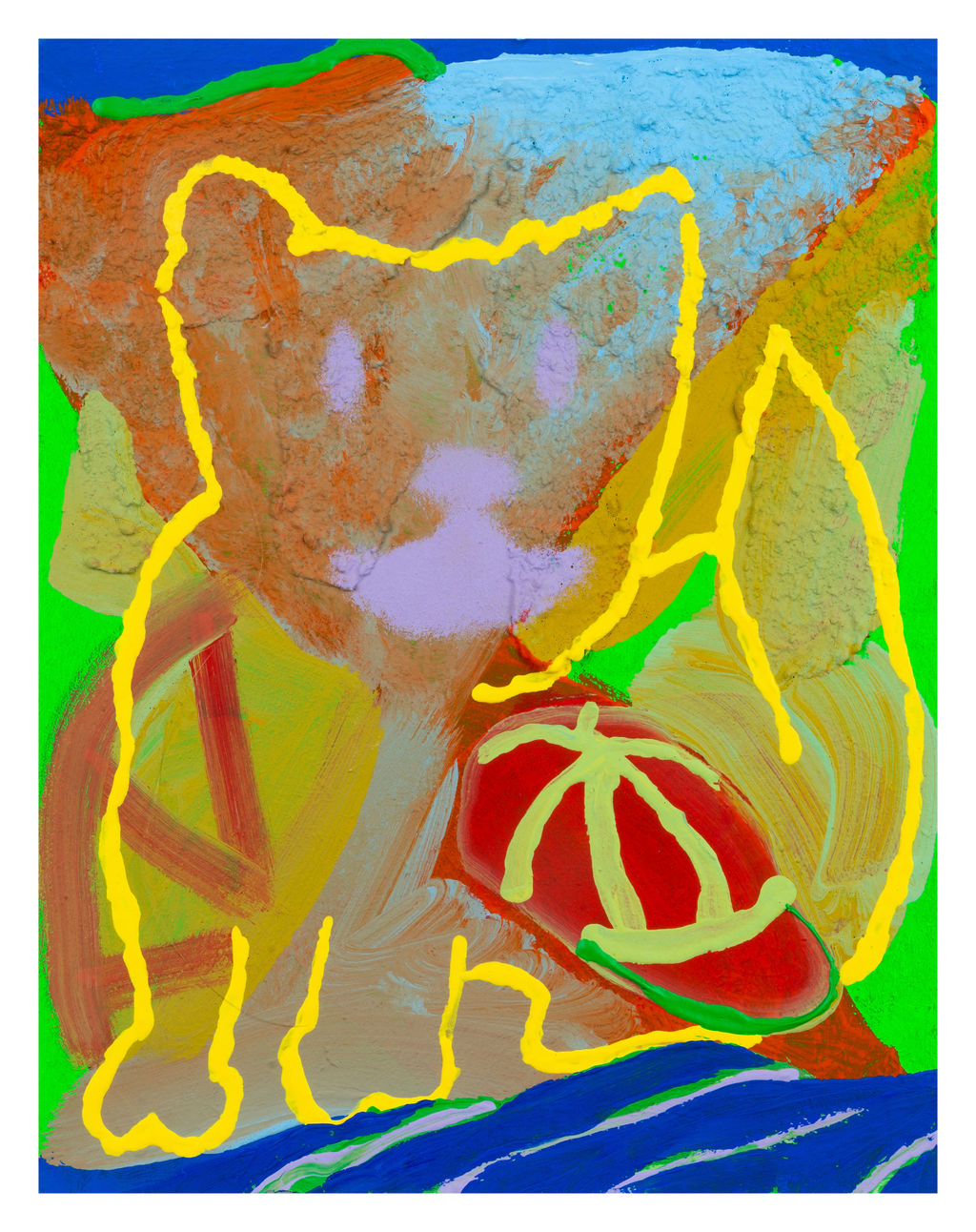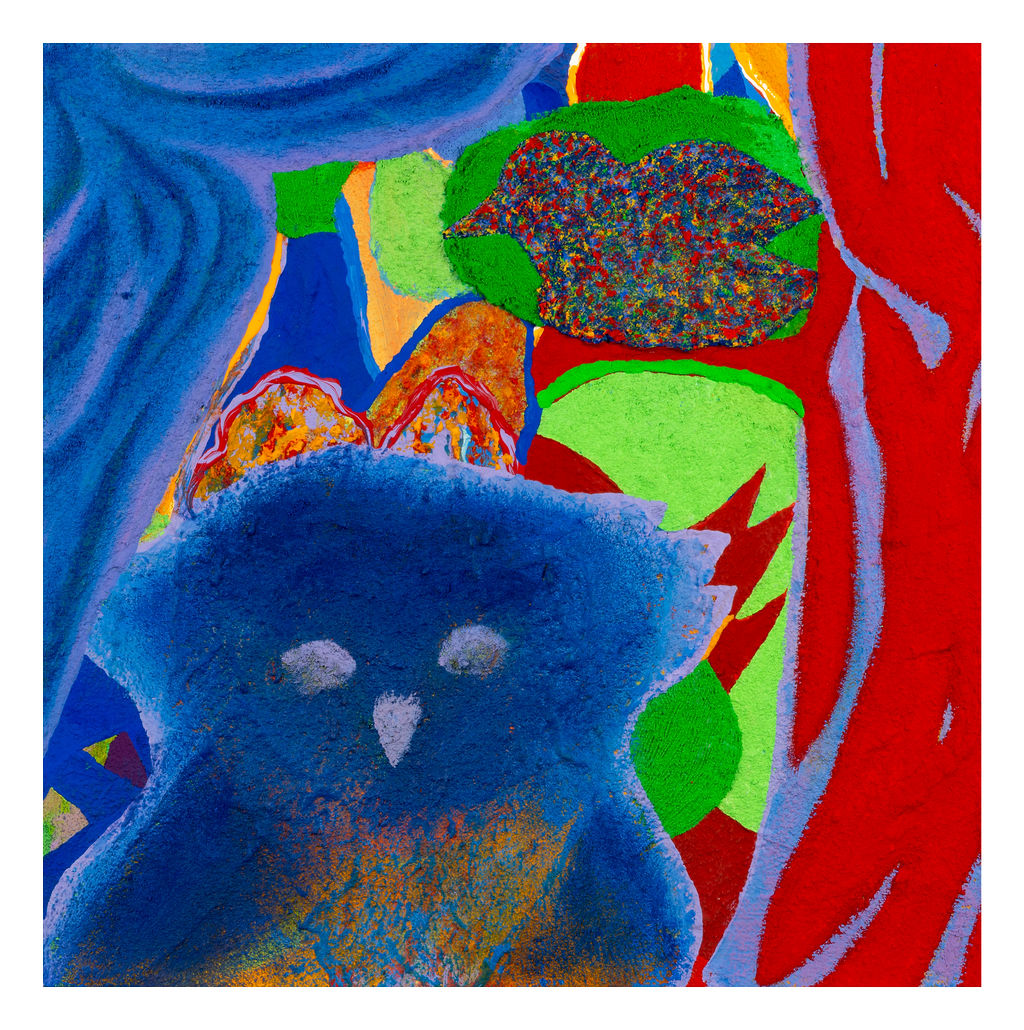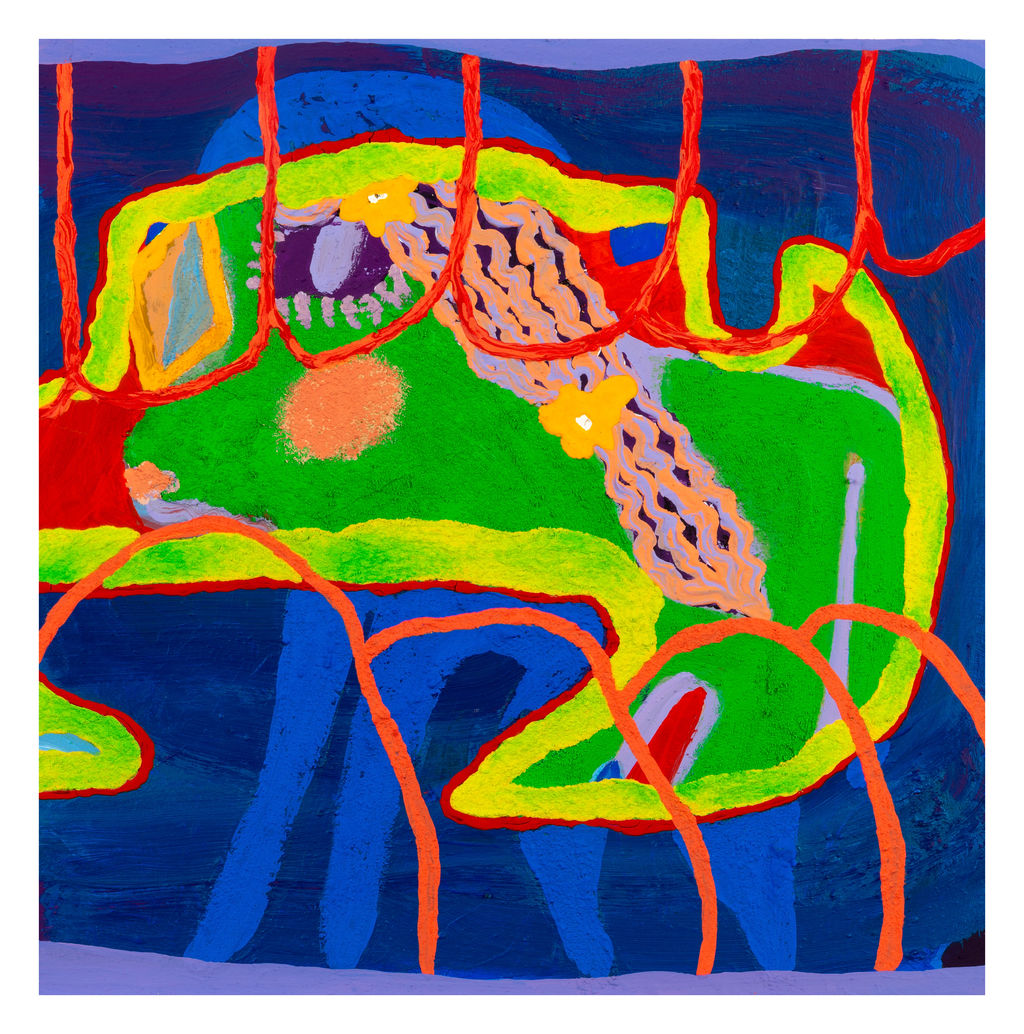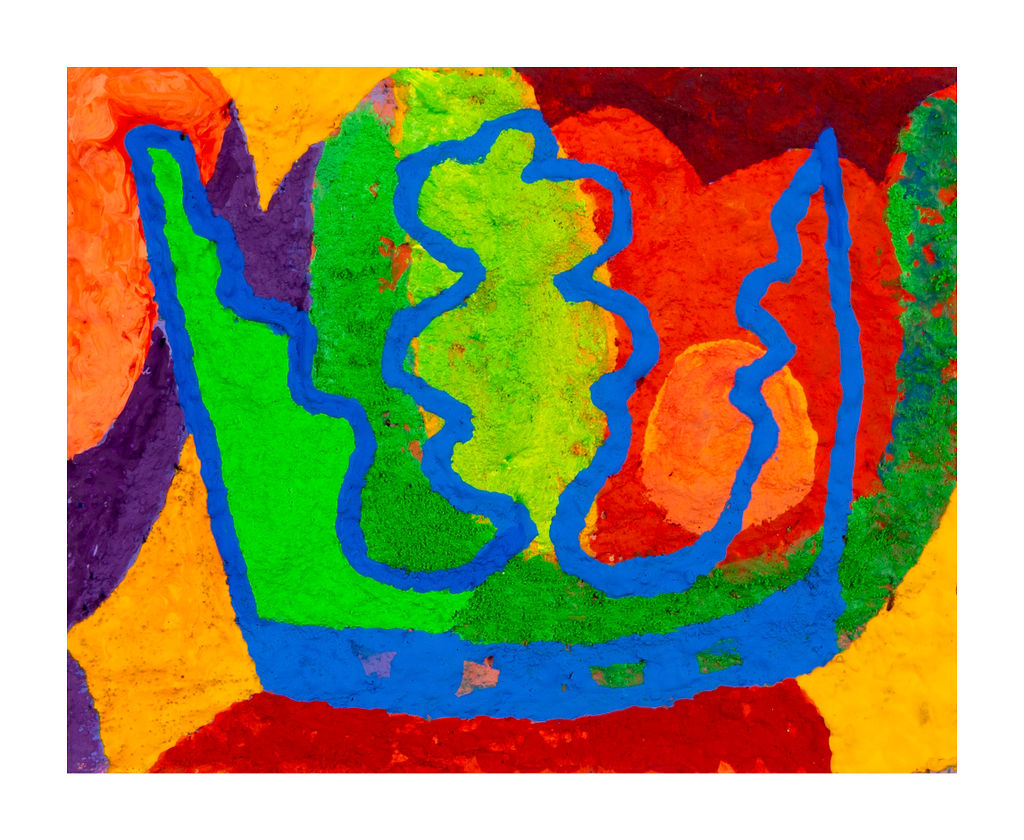EXHIBITION
Space Invaders
Artist: Fiona Blake
Read More
Condition: Parkinson’s Disease
This person sees strangers in his house no one else can see. Young children rush about damaging furniture and writing on the walls. He waves his stick at them in frustration and they slip away through the walls. They watch and talk but he cannot hear them. This work references El Greco’s ‘The cleansing of the temple’ but here the viewer drives the intruders out of the house. The sombre tones evoke an anxious and oppressive waking dream.
Quote 1
Quote 2
Quote 3
Let Me Have Peace
Artist: Sarah Dodkin Rush
Read More
Condition: Schizophrenia
The second artwork was inspired by the moving account given by the patient. It was so obviously hard for them to tell us about their experiences so perhaps I have been a little more obvious in this image by including the lowered head of the patient themselves holding their head in despair whilst clutching a crucifix on a chain to show how their faith helps them. This person mentioned a kind Indian who guided them and an angry swan. They also mentioned lies being whispered to them which confused them mightily.
The typical totem pole I included is taken from the west coastal Indians of the North American continent. This includes the figures of the Thunderbird, who is said to control the weather and denotes power, mysticism and leadership on a totem pole.
The Bear stands for strength and authority, motherhood, teaching and humility. The strength shown by the patient to even talk to us.
The Wolf is seen as a cunning hunter, also they represent loyalty and family ties. The family ties of the modern family made up of friends and sometimes relatives who are close to you.
The Snake represents change, medicine and fertility. The Snake shedding their skin is like the two sides of the patient. The person and their illness.
The beaver symbolises creativity and determination.The ability of the patient to carry on.
The two people in the image are outlined in white to represent goodness while the angry swan is outlined in black to indicate aggression. The swirls in the background represents the lies being whispered to the patient.
He Only Comes When I Am Alone
Artist: Jenny Souter
Acrylic on canvas, 39cm x 44cm. (2021)
Read More
Condition: Parkinson’s Disease
The unconscious is inexhaustible and uncontrollable. Its force surpasses us. It is as mysterious as the last particle of a brain cell. Even if we knew it, we could not reconstruct it.’ (Tzara, T.1922). This image is a response to meetings on zoom with a patient suffering from Parkinson’s disease. The narrative of painting is a layered dialogue. This art piece is an attempt to portray a felt experience exploring a specific hallucination, one that involves a male Victorian funeral bearer, like an image often portrayed as a ‘grim reaper’. I have become a witness, the patient in the painting is facing me, there are now three people in the room or art piece, myself, the patient, and the vision.
As I face the patient witnessing the hallucination, I hear the dialogue between the patient and myself. ‘I am the colour, colour is safe’ ‘He is the shadows. My response to these words is fill the patient with colour. I asked, ‘what do you do when he appears?’ the answer was; ‘I centre myself and remain calm, then I begin to realise he is not real’. I have intentionally made the arms and hands and fingers longer, trailing and seeking the ground in an urgent quest for stability, pursuing what is real and felt through the body. The coloured figure emerges, in a standing position, facing me with only the eyes, twisted sideways, seeing the funeral bearer from a peripheral viewpoint. The eyes navigate what is around us to ‘make sense’ or decipher information for survival, and that evidence is processed first. The image, projected out of the mind, becomes strengthened when it has been defined. He has been given an identity, personality and assigned to his place as a threat rather than a gain. The character has had a verb applied to it, ‘he watches me’, this is one of power over the patient.The words became more influential to me and it is for that reason I have included them in the painting. They are hand painted to reveal a sense of self and feeling rather than a documented format, which implies authority and constitution. The language dictates an emotion of fear and a questioning of ‘self’. ‘He watches me’. ‘Why does he watch you’, I asked? ‘He is waiting for me.’ This potential threat to self becomes evident because the figure has become individualised. The patient knows he is not real but still fears him. I asked, ‘do you call a friend?’ The patient replied, ‘no, I would be worried about what they would think of me’.Upon reflection, it occurred to me that the patient must not only feel judged by the figure, but in addition, potentially by other people.The courage of the patient in the first instance, to relay her experiences to a stranger is enabling, and secondly, to remain calm to ‘place him as unreal’, when the mind has told her he is actual is empowering. The ‘knowing that we know’ part of ourselves, wins through and the reoccurring temporary battle is won.
I Followed The White Lines In The Sky
Artist: Jenny Souter
Watercolour and ink on stretched canvas, 40cm x 40cm. (2021)
Read More
Condition: Schizophrenia
The patient said, ‘one day I followed the white lines in the sky for miles. The white lines came from the aeroplane that was following me. I thought that if I tracked them to the end, they would stop pursuing me and leave me alone. I trailed them for miles and miles all day until it went dark, and I couldn’t see them anymore, after that I went home’.The painting I have chosen to make is a cohesion between two primary sketches, one of an aeroplane and the patient underneath enveloped by an ethereal mosquito net, and the other is a sketch of the patient walking looking at the sky. In both sketches the patient is predominantly yellow, because that is the colour the patient identifies with as a sense of self. Utilising materials that explained an ethereal state of being, I have used watercolours and a type of material that dissipated the colours leading to a blur. This ‘blur’ signifies and mirrors how I see the side that ‘self-questions’ that is, to some extent controlled by the visions and voices that are seen and heard. The mosquito-type net that is connected to the patient, also reinforces the relationship between the aeroplane and the patient, one cannot be without the other. The patient in the painting is looking upwards at the aeroplane, whilst continually walking, the fists are clenched in a determination to strive forwards and not give up, (I walked for miles and miles all day, until it was dark). The patient is yellow and also the connection to the aeroplane, in addition to the patient’s shadow, which can be defined as a concrete sense of self.
Tears In Rain
Artist: João Abbott-Gribben
Read More
Condition: Schizophrenia
Both works consist of symbols layered on top of one another. Each symbol represents a concept that my interviewee, an artist going by the moniker SK172, wanted included in the pieces I made.The symbols cover concepts such as surveillance, technology, virtual reality and science-fiction. The films, books and video games that SK172 likes best often touch on these genres and ideas. They also play into some of the hallucinations SK172 described, for example their movements and thoughts being watched and tracked with technology operated by malign forces. The symbols in the works also refer to SK172’s own art practice, particularly the motifs they use to articulate aspects of their experience of schizophrenia.
Star Citizen
Artist: João Abbott-Gribben
Read More
Condition: Schizophrenia
Both works consist of symbols layered on top of one another. Each symbol represents a concept that my interviewee, an artist going by the moniker SK172, wanted included in the pieces I made.The symbols cover concepts such as surveillance, technology, virtual reality and science-fiction. The films, books and video games that SK172 likes best often touch on these genres and ideas. They also play into some of the hallucinations SK172 described, for example their movements and thoughts being watched and tracked with technology operated by malign forces. The symbols in the works also refer to SK172’s own art practice, particularly the motifs they use to articulate aspects of their experience of schizophrenia.
The Uninvited
Artist: Sarah Dodkin Rush
Read More
Condition: Parkinson’s Disease
The first artwork created by working with the Parkinson’s patient comes across as a very calm image. This was inspired by the person themselves, who, having experienced images of people who have passed on in their prior life, was, at first, untroubled by their visits. At first, they were people they knew, so felt secure in their own memories.
Groups of people chatting started to appear but were elongated and raised above the ground as if they were projected from another time or space. They ignored their viewer.
Consequently, as strangers began to appear in stages of undress, children playing next to them on the sofa and males behaving inappropriately, they felt far less comfortable.
Currently shouting at the people to leave, works, as they start to fade away within moments. Therefore, I painted the very slim chatting people who were standing, above the ground whilst also portraying a single male, who, with direct gaze, at the viewer, was touching himself inappropriately. I decided not to make what he was doing too obvious.
Exposure
Artist: Fiona Blake
Read More
Condition: Schizophrenia
This person hates going out as he hears passer-by commenting on him negatively. He feels overwhelmed by such comments and so stays at home more than he would like. Even at home he feels that people in the trees opposite his home observe him by sending x-rays into his home. This painting aims to evoke the verbal assault my patient experiences whenever he leaves his home and the discomfort of being observed and criticised even at home.
Foxy Dog And I
Artist: Jennifer Caroline Campbell
Read More
Condition: Parkinson’s Disease
Activity gathering.
That shouldn’t be there.
Welcome the birds in, eyes sharply open.
Outside becomes inside becomes outside.
Visitors unchosen.
Interruptions shape life, momentum momentum.
Window Flocks
Artist: Jennifer Caroline Campbell
Read More
Condition: Parkinson’s Disease
Activity gathering.
That shouldn’t be there.
Welcome the birds in, eyes sharply open.
Outside becomes inside becomes outside.
Visitors unchosen.
Interruptions shape life, momentum momentum.
Saving Spiders
Artist: Jennifer Caroline Campbell
Read More
Condition: Parkinson’s Disease
Activity gathering.
That shouldn’t be there.
Welcome the birds in, eyes sharply open.
Outside becomes inside becomes outside.
Visitors unchosen.
Interruptions shape life, momentum momentum.
Daily Thought Intrusion
Artist: Jennifer Caroline Campbell
Read More
Condition: Schizophrenia
The human brain is just lumpy cell bundles, yet we are completely dependent on it: it is us.It is not fixed like concrete but changeable like un-fired clay.This hand has glossy green nails. It is the intruderbut it is made of the same stuff as the thing that’s being intruded upon.OR the hand is not theintruder,it embodies self-will: the sensation of shaping one’s own automatic thoughts, to intervene.It draws the attention of the eye, who is trying not to look. OR is the eye controlling the hand.These different readings question who is in control, which part of us.
Plastic Pony Chew Chase
Artist: Jennifer Caroline Campbell
Read More
Condition: Schizophrenia
This collaboration made me think into a younger me, silly hair clips, influenceable, hyper gendered, a product of her time.
My Little Pony: absurd mutated innocence.OR she is a frog, ready to transform.Something machine-like is threatening to chew her up. An aggressive shape or a computer console controller.That feeling of being observed. By who? Afuture self or someone outside?
Monarchy Shift
Artist: Jennifer Caroline Campbell
Read More
Condition: Schizophrenia
Sun setting, a daily cycle.The repeating prize of a crown: a deserving gift I wish I could give to all who experience relentlessvoices.The crown also symbolises perpetual power strugglesand the aggression of internal dynasties.The shapes behind are shifting and ungrounded. The red shadow reaches out of the painting, into the past and into the now.Wehave to livewith the unsolved, but this unsolved state can fluctuate. It can be shaped by changes of circumstance, encounters and the passing of time.

